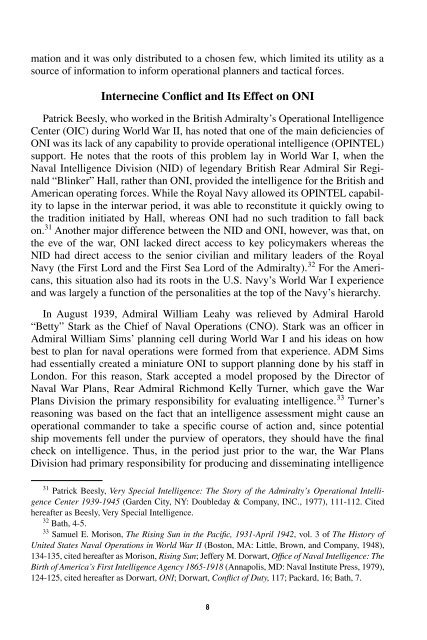ships in violation of treaty limits, yet secretly building the Yamato class battleshipand re-boilering older vessels behind large screens at their building docks. 23Given this dearth of information, ONI analysts and collectors naturally appliedtheir biases to assessments of Japanese capabilities, erroneously evaluating thequality of the Japanese naval fleet and their naval air forces as low. 24Despite the lack of success against the Japanese target, ONI’s other HUMINToperations were more profitable. The American Legation, United States NavalAttaché, London (ALUSNA London), which will be discussed extensively inchapter 5, was a critical node for the flow of intelligence and technical informationinto ONI. ONI attachés in Latin America also had considerable successes inproviding worthwhile intelligence and countering the moves of Axis intelligenceoperatives and subversive elements in the countries to which they wereassigned. 25 By June of 1940, the Navy also took steps to strengthen its clandestineHUMINT capabilities and had relatively good success with these assets inNorth Africa and Mexico, although this capability would be absorbed by theCoordinator of Information (COI) the following year. 26SIGINT was also a major source of intelligence for ONI. The first Navy HighFrequency Direction Finding (HF/DF) sites were established in 1918 and the U.S.had some success against foreign codes during the 1920s and 30s. 27 By the1930s, the Navy and the Army had three major cryptologic collection siteslocated at Corregidor (Cavite or Station CAST) in the Philippines, Pearl Harbor,and Washington, DC. 28 The collection and decryption of the intercepted communicationswas handled by Director of Naval Communications OP-20-G, the“Communications Security Section,” while much of the translation and analysisof the decrypted communications was handled by ONI. 29 While the Navy’s cryptanalyticsection was several times larger than the Army’s at the start of the war,at around 147 personnel, the Navy had negligible success against the main Japanesenaval code, designated JN-25, until just before the war, when cooperationwith British communications intelligence (COMINT) personnel became morecommon. 30 Although information gathered from the Japanese diplomatic codewas an important source of intelligence, it contained virtually no military infor-23Malcolm Muir, Jr., “Rearming in a Vacuum: United States Navy <strong>Intelligence</strong> and the JapaneseCapital Ship Threat, 1936-1945,” The Journal of Military History 54, no. 4 (October 1990): 473-477.24Muir, 478-479; Dorwart, Conflict of Duty, 27-29.25Dorwart, Conflict of Duty, 106-109.26 Packard, 130.27 Aldrich, 33.28 Worth, 11-12.29Jeffrey K. Bray, Ultra in the Atlantic (Laguna Hills, CA: Aegean Park Press, 1994), xii-xiv.30Aldrich, 73.7
mation and it was only distributed to a chosen few, which limited its utility as asource of information to inform operational planners and tactical forces.Internecine Conflict and Its Effect on ONIPatrick Beesly, who worked in the British Admiralty’s Operational <strong>Intelligence</strong>Center (OIC) during World War II, has noted that one of the main deficiencies ofONI was its lack of any capability to provide operational intelligence (OPINTEL)support. He notes that the roots of this problem lay in World War I, when theNaval <strong>Intelligence</strong> Division (NID) of legendary British Rear Admiral Sir Reginald“Blinker” Hall, rather than ONI, provided the intelligence for the British andAmerican operating forces. While the Royal Navy allowed its OPINTEL capabilityto lapse in the interwar period, it was able to reconstitute it quickly owing tothe tradition initiated by Hall, whereas ONI had no such tradition to fall backon. 31 Another major difference between the NID and ONI, however, was that, onthe eve of the war, ONI lacked direct access to key policymakers whereas theNID had direct access to the senior civilian and military leaders of the RoyalNavy (the First Lord and the First Sea Lord of the Admiralty). 32 For the Americans,this situation also had its roots in the U.S. Navy’s World War I experienceand was largely a function of the personalities at the top of the Navy’s hierarchy.In August 1939, Admiral William Leahy was relieved by Admiral Harold“Betty” Stark as the Chief of Naval Operations (CNO). Stark was an officer inAdmiral William Sims’ planning cell during World War I and his ideas on howbest to plan for naval operations were formed from that experience. ADM Simshad essentially created a miniature ONI to support planning done by his staff inLondon. For this reason, Stark accepted a model proposed by the Director ofNaval War Plans, Rear Admiral Richmond Kelly Turner, which gave the WarPlans Division the primary responsibility for evaluating intelligence. 33 Turner’sreasoning was based on the fact that an intelligence assessment might cause anoperational commander to take a specific course of action and, since potentialship movements fell under the purview of operators, they should have the finalcheck on intelligence. Thus, in the period just prior to the war, the War PlansDivision had primary responsibility for producing and disseminating intelligence31 Patrick Beesly, Very Special <strong>Intelligence</strong>: The Story of the Admiralty’s Operational <strong>Intelligence</strong>Center 1939-1945 (Garden City, NY: Doubleday & Company, INC., 1977), 111-112. Citedhereafter as Beesly, Very Special <strong>Intelligence</strong>.32Bath, 4-5.33 Samuel E. Morison, The Rising Sun in the Pacific, 1931-April 1942, vol. 3 of The History ofUnited States Naval Operations in World War II (Boston, MA: Little, Brown, and Company, 1948),134-135, cited hereafter as Morison, Rising Sun; Jeffery M. Dorwart, Office of Naval <strong>Intelligence</strong>: TheBirth of America’s First <strong>Intelligence</strong> Agency 1865-1918 (Annapolis, MD: Naval Institute Press, 1979),124-125, cited hereafter as Dorwart, ONI; Dorwart, Conflict of Duty, 117; Packard, 16; Bath, 7.8
- Page 1 and 2: COURTING A RELUCTANT ALLYAn Evaluat
- Page 4: The Joint Military Intelligence Col
- Page 8 and 9: FOREWORDTo most Americans alive tod
- Page 10 and 11: PROLOGUESince World War II, the Uni
- Page 12 and 13: Chapter 1THE STATUS OF INTELLIGENCE
- Page 14 and 15: action, a propaganda unit, or an ec
- Page 16 and 17: officers assisted by 20 civilian cl
- Page 20 and 21: assessments. By 1941, ONI was releg
- Page 22 and 23: might bear on their work.” 39 As
- Page 24 and 25: ility over time, its operational in
- Page 26 and 27: Chapter 2U.S.-UK RELATIONS, 1914-19
- Page 28 and 29: told by the Chief of Naval Operatio
- Page 30 and 31: ups of the early 20th century. 65 T
- Page 32 and 33: firmly believed that British polici
- Page 34: ecame one of the primary sources of
- Page 37 and 38: of shoring up their strategic weakn
- Page 39 and 40: mon framework for negotiation with
- Page 43 and 44: assuaged British concerns about the
- Page 45 and 46: In the area of intelligence exchang
- Page 47 and 48: clear to the Americans that if they
- Page 49 and 50: in his mind worked against closer c
- Page 51 and 52: praised the fighting spirit of the
- Page 53 and 54: through November of 1940 persuaded
- Page 55 and 56: and Great Britain. His principalcon
- Page 57 and 58: eceived by the British and from the
- Page 59 and 60: gear designed by the British. Altho
- Page 61 and 62: American Attitudes On Intelligence
- Page 63 and 64: information did have an impact on K
- Page 65 and 66: the affair. 183 This lack of resent
- Page 67 and 68: tion exchanges. Even more significa
- Page 69 and 70:
nation (BSC) mission, is now availa
- Page 71 and 72:
good will and encouraged greater co
- Page 73 and 74:
would merely show Donovan “the be
- Page 75 and 76:
Lothian passed Hill’s proposal to
- Page 77 and 78:
still a powerful influence. While Z
- Page 79 and 80:
Since the Tizard Mission had only a
- Page 81 and 82:
appropriating large increases to th
- Page 83 and 84:
the French, a point which would not
- Page 85 and 86:
equested that RADM Ghormley remain
- Page 87 and 88:
when he [Pott] comes to O.N.I. he i
- Page 89 and 90:
it was not official U.S. policy. St
- Page 91 and 92:
efforts that had begun with the Sta
- Page 93 and 94:
high-level ABC-1 staff talks which
- Page 95 and 96:
to successfully interpret the instr
- Page 97 and 98:
to little more than a nebulous stat
- Page 99 and 100:
to offer.” 319 Others in the Brit
- Page 101 and 102:
Operational Intelligence Cooperatio
- Page 103 and 104:
Godfrey’s main concern was most l
- Page 105 and 106:
possesses complementary capabilitie
- Page 107 and 108:
2. Be prepared to give something of
- Page 109 and 110:
had in forming its own Joint Intell
- Page 112 and 113:
GLOSSARYABC-1ALUSNALondonBGENBSCCAP
- Page 114 and 115:
APPENDIX AA NOTE ON SOURCESArchival
- Page 116:
APPENDIX BMAJOR EVENTS IN U.S.-UK I
- Page 119 and 120:
________. Foreign Relations of the
- Page 121 and 122:
________. “The Secret of the Chur
- Page 123 and 124:
Zacharias, Ellis M., CAPT, USN. Sec
- Page 126 and 127:
INDEXAABC-1 Talks 41, 57, 74-75, 78
- Page 128 and 129:
IImagery Intelligence (IMINT) 12, 8
- Page 130 and 131:
Signals Intelligence(SIGINT) 2-3, 7
- Page 132:
PCN 53512ISBN 0-9656195-9-1
















